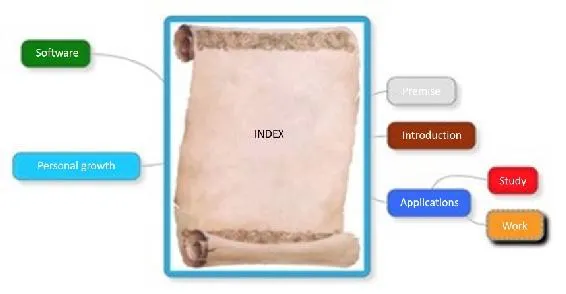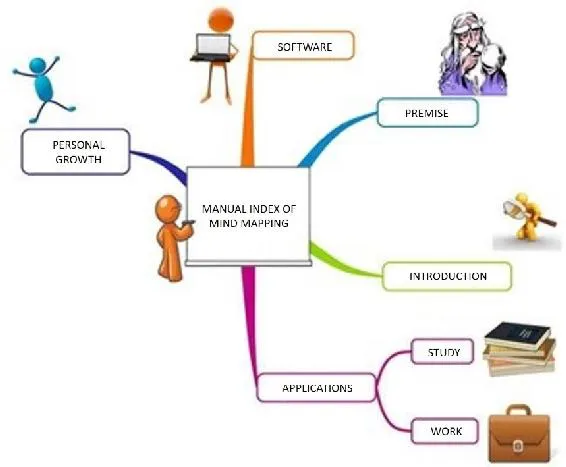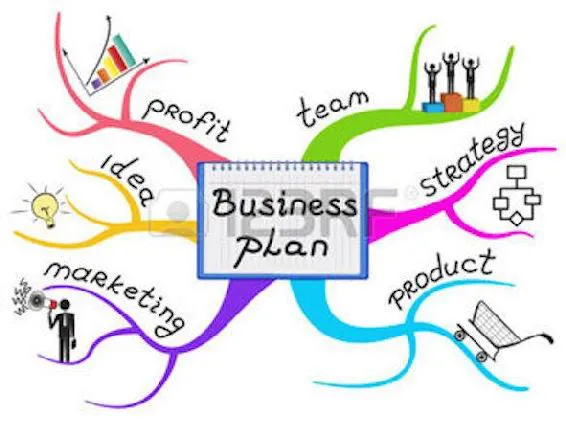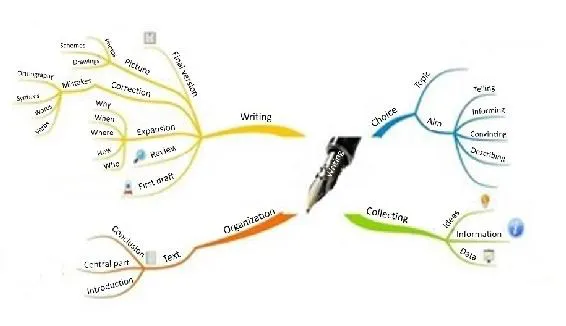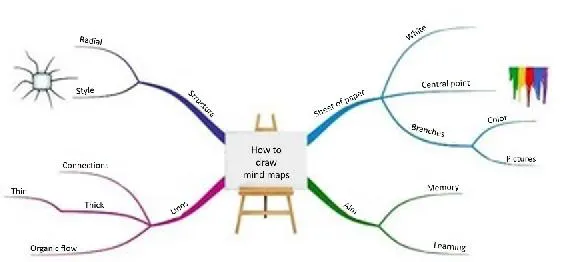![]()
1. INTRODUCTION TO MIND MAPS
1.1. What are mind maps
I guess you already read the index. Very well.
How do you think that jumble of words can best be reproduced in order to best memorize it?
We will get to that.
First of all, as I am sure you understand, we will need several maps.
Why do you think?
Do you remember the song from the beginning? “Parole… Parole… Parole…”. Words… words…. words…
A lot of ideas explained all together can cause confusion and difficulty in memorization.
Therefore, we will first create one map enclosing all areas of the main topics and then a few sub-maps for the paragraphs. These will be expressed by means of key words or concepts.
Let us proceed with examples, it will all be clearer.
Here is a mind map of our index with the Google MindMap software (we will talk about available options in the last chapter).
How does this representation make you feel?
First of all, let me say it is a good software (what is more, it is free). I represented things like this on purpose to make you understand a few things.
The key points are all there and are even distinguished by different colors. The image of the scroll representing the concept that is to be developed is undoubtedly too big for the font.
It is true that the concepts to be remembered are so few that even with such a rough representation it may not be too hard to memorize. Still, something is amiss.
What? How can I remember everything better?
Associating to pictures!
Let us take that map and put images in it. I chose some, but you might have chosen different ones. The premise reminds me of a crystal ball showing in broad terms what is inside the book; in the introduction, tools and equipment to learn the tricks of the trade, and so on.
You may notice that the pictures by themselves are clearer than the words (which are in the background, and this is why I chose a barely readable font size); furthermore, that representation is far more interesting and certainly more involving, it raises questions in us.
What does our wizard see in the crystal ball? How can I become better at studying, or at work? It intrigues us, drawing our attention.
Now take markers, gel pens and blank paper, both A3 and A4, and a sketchbook.
Try to draw those lines reproducing exactly what the program did; instead of the pictures I chose, let your imagination run free and insert your own. Do not worry if the drawings will not be great, they can also be sketches. The important thing is that the pictures you chose somehow stimulate your imagination, your sensibility. In the premise, for instance, you may also draw an opening door.
![]()
The mind map made by the ImindMap software by Tony Buzan looks like this:
A mind map is by definition a representation of concepts expressed through key words. It is a hierarchical system: from every concept, another may arise. Pictures are used to ease memorization of concepts.
Carefully observe a mind map, extrapolated from the web, which shows the uses of mind maps (the last one at the end of this dissertation). It really gives a clear idea of what I just said.
Do that while I tell you all the cardinal rules.
At the center of the map we start off with the concept that we want to dissect or discuss in its facets. This must be represented by a picture. In our example, the author of the map used a palette. We can let our imagination run free and use whatever we want.
Starting from this parent concept, children concepts branch out which may in turn give rise to other children concepts. On these branches we may place an image or a drawing inspired by our creativity.
The branches should go clockwise starting from the most important (as a concept, because part of a hierarchy of topics to be discussed, or simply according to an arbitrary order).
Let us go back to the index and try to associate the descriptive index and the map one.
The words must be as long as the branch itself. We use capital letters for better clarity, but a clear cursive is also acceptable.
The resulting whole should look balanced and roughly symmetric.
I would like to stress again that no one cares in the least about your drawings and it does not matter if they resemble a Picasso or not.
The important thing is that even from a sketch you may already remember all the facets of the concept. Were it not the case, change the picture in order to find a more functional one, one that is able to stimulate your memory, your sensibility and your interest.
I also attach other mind maps (one on creativity and another one on the rules of mind mapping). Exercise: try to understand how they respect the few rules listed above.
It is also possible (even compulsory), to exercise. Keep drawing and writing, even making mistakes and repeating the same map countless times until it is perfect. You may also download pictures and copy them, so as to have a higher familiarity with mind maps.
After finishing the above exercise, and assuming you have everything you need at your disposal, make your first mind map. Topic: creativity. Give free rein to your imagination! Let us insert at least eight branches with relative sub-branches (as many as you feel are needed).
Once completed, look at it again, with care.
Close your eyes and check if you can remember it without effort. If so, you did a marvelous job!
If not, it means that you probably did not choose the right pictures to stimulate your memory adequately. Change them, making a new map.
Go on like this until you can keep in mind all the steps of the map.
In the following pages you may find three well-made mind maps and, in the “attached” section at the end of the book, you will find other examples of mind maps, among which the one for our index.
![]()
1.2. The elements of mind maps: colors, shapes, lines, pictures, words
Mind maps contain different elements which, as we just said, allow the brain to observe its activity as if from the outside.
Colors convey emotions which, depending on the mood, may provoke different reactions in the beholder.
Allow me to tell you something on the meaning of colors, so that you may better understand their use in a mind map.
The classic red, naturally associated with passion and romance, conveys mainly vigor, strength, and dynamism. It may also evoke alarm, aggression, violence and may awake instincts for power. It stimulates rapid decision making. It is, in fact, often used on the web in “click here” or “order now” buttons.
The darker it is, the more vigorous. The lighter it is, the more passionate and sensual.
Green is instinctively associated with nature. A lush and fertile nature. The sensations conveyed are of freshness and health. Teal even points to healing and protection.
Blue is almost the opposite of red. It means sea, calmness, and relaxation.
It draws constant commitment and intelligence and can therefore be used to highlight ideas expressing veracity and trustworthiness.
Another noteworthy color is brown. What does this color remind you of? Firstly, it is the color of the trunk of bushes. You can easily associate this color to nature (in combination with green), to growth and, why not, to life as birth and creation.
Think of the branches of a tree. A tree with all its main and secondary branches should at this point remind you of the structure of a mind map.
It should also evoke sensations of stability and security; it is the color of wood, of the domestic fireplace; the darker it is and the more it awakens sensual overtones.
Yellow is the color of the Sun, of light and of gold. It is the most visible out of all colors, use it to highlight something renowned and valuable. It evokes wisdom, creativity, intelligence. It may also be used to emphasize preparatory situations, inducing concentration before the action (as in the case of traffic lights).
You will use grey in those cases where it is appropriate to underscore the sadness of a situation. It may also be used as a neutral color to reinforce in a cold and stern manner an idea that was already expressed through another color.
Naturally, the final result depends on the combination of the colors.
Cold colors highlight the negativity of a situation, the neutral ones underscore the “warm” overtone if in combination with a warm color and the opposite with cold colors.
No need to become a master of color like Michelangelo to make a mind map. Simply, in my opinion, these small curiosities I am telling you about may really bolster your creativity (which I will get to in just a moment).
This way, you will truly learn to analyze the situations in a cerebral way. Memory and memorization are stimulated by the use of color, as I mentioned earlier.
There are also binary colors, which result from the combination of two shades: orange and purple.
Orange reflects the characteristics of yellow and red together. It is a celebratory color, it evokes happiness and good mood. It is very popular among children. And we should become like children, remember?
In its bluer shades, purple (my favorite color!) is cold and calm, if not royal and majestic. It may express sadness and melancholy, possibly doubt and distrust (in the West, since it is often used for funerals, it may also be considered gloomy). It may also be associated with magic and the occult world. Widely used among the European nobility, it is the color of art and culture.
Black is a very ambiguous color. Traditionally mournful, it represents death. Recently, though, it is considered very elegant; it underscores the weaker shades, making the brighter and more saturated.
Stern and ceremonial color, it also evokes mystery.
Associating certain colors to white, on the other hand, you obtain the opposite effect: they become dull.
White expresses purity, calm and peace. It is associated with cleanliness and hospitals.
There, if I wanted to express such a concept in a drawing, I would certainly not use brown, which also represents soil and may evoke sensations of “dirt”.
Many authors have dedicated themselves to the psychology of colors. Should you be interested in the topic, please refer to the bibliography.
The colors in a mind map are extremely important. The colors of the main and secondary branches will help you give clarity to your mind map. They will hel...

